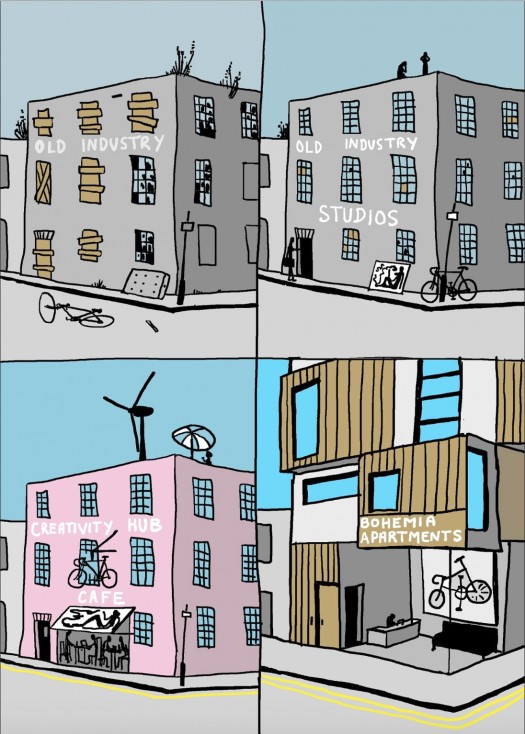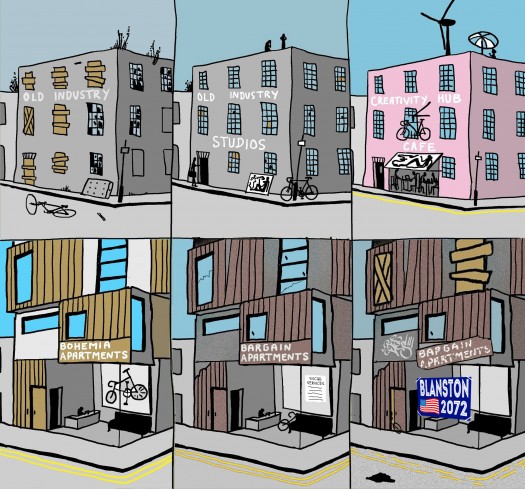A Placemaking Journal
Here Today, Gone Tomorrow, Here the Day After That
They may not be new but I was recently introduced to a series of comics by English artist Grayson Perry taking on the world of creative arts, particularly one entitled “Gentrification.”
The tale is familiar. Old industry fades, artists take possession of the infrastructure, ragtag commerce blossoms and, ultimately, evolves into something only fleetingly reminiscent of what it once was. Laid out by Perry, it’s biting and funny stuff that deftly pushes all the cynical buttons we’ve adopted as self-defense mechanisms against a world in a constant state of flux.
Of course I appreciate the humor but something else struck me as well: When you view a moment in time as a series of comic panels, it implies a starting and ending condition. It’s a narrative arc that begins, builds and concludes, and makes for the easy insertion of heroes and villains.
But that’s not really how cities work, is it?
Consider what preceded that old industry in frame one: Most likely a pasture and stream, perhaps some simple settlement shacks or modest homes. Then industry emerged. It grew over time, becoming increasingly pervasive and powerful. Ultimately, it became consuming in many ways until its growing culture of exploitation was tempered by the efforts of the workers’ rights movement. Thereafter, in the wake of War, it became the engine of the middle class.
None of that is pictured in the comic though, because doing so — showing incremental and repetitive cycles of urban development (and redevelopment) — would undermine the statement. I get it. And I also respect the imperative to be funny.
But it made me wonder. What would be a more accurate version of the same comic? So I broke out the Photoshop and mocked up an alternative. One that, while not telling the whole story (because you can’t), is at least more forthright about our urban patterns of repetition over time. So here it is:
Given the time investment, I began the comic at the same point but then carried it forward two additional frames in which the ever-so-cringe-worthy hip new apartment building follows a perfectly reasonable trajectory — devolving over time into more affordable, second tier rental housing then, ultimately, becoming a largely abandoned shell to be re-purposed by those seeking space and opportunity at below market cost. In short, the point also reflected in panel two of the original comic.
Is this the way things will play out? No one can say for certain but it’s a reasonable proposition. Today’s new, market rate housing is tomorrow’s more affordable second tier housing. And that’s something we don’t want to acknowledge because, if we do, we have to also acknowledge that today’s efforts to stop the construction of new housing might in effect be stealing housing from tomorrow’s workforce.
That’s a tension currently playing out in high cost markets around the country (something explored last week by my colleague, Ben Brown) where factions on one side advocate for significant new investments in housing to meet exploding demand and ultimately cool costs (YIMBYs) while those on the other side push for neighborhood preservation to keep new development, which is seen to usher in higher costs for all, at bay (NIMBYs), both adamant that they represent the solution to rapidly escalating costs.
The Iroquois Indians, it’s worth noting, had a framework for considering exactly this type of issue, one that pinned their actions to outcomes seven generations down the line. In weighing their decisions, they placed high emphasis on how such actions might impact their kids, and their kids’ kids, and so on, looking roughly a century and a half out.
In many ways, the side you’re on in today’s urban development culture wars reflects your level of concern, either conscious or subconscious, for those not yet born. That alone should make one’s positions on these issues something well deserving of self-reflection, and plenty of it.
–Scott Doyon
If PlaceShakers is our soapbox, our Facebook page is where we step down, grab a drink and enjoy a little conversation. Looking for a heads-up on the latest community-building news and perspective from around the web? Click through and “Like” us and we’ll keep you in the loop.











